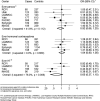A Pooled Analysis of Reproductive Factors, Exogenous Hormone Use, and Risk of Multiple Myeloma among Women in the International Multiple Myeloma Consortium
- PMID: 26464426
- PMCID: PMC4745255
- DOI: 10.1158/1055-9965.EPI-15-0953
A Pooled Analysis of Reproductive Factors, Exogenous Hormone Use, and Risk of Multiple Myeloma among Women in the International Multiple Myeloma Consortium
Abstract
Background: Female sex hormones are known to have immunomodulatory effects. Therefore, reproductive factors and exogenous hormone use could influence the risk of multiple myeloma in women. However, the role of hormonal factors in multiple myeloma etiology remains unclear because previous investigations were underpowered to detect modest associations.
Methods: We conducted a pooled analysis of seven case-control studies included in the International Multiple Myeloma Consortium, with individual data on reproductive factors and exogenous hormone use from 1,072 female cases and 3,541 female controls. Study-specific odds ratios and corresponding 95% confidence intervals (CI) were estimated using logistic regression and pooled analyses were conducted using random effects meta-analyses.
Results: Multiple myeloma was not associated with reproductive factors, including ever parous [OR = 0.92; 95% confidence interval (CI), 0.68-1.25], or with hormonal contraception use (OR = 1.04; 95% CI, 0.80-1.36). Postmenopausal hormone therapy users had nonsignificantly reduced risks of multiple myeloma compared with never users, but this association differed across centers (OR = 0.65; 95% CI, 0.37-1.15, I(2) = 76.0%, Pheterogeneity = 0.01).
Conclusions: These data do not support a role for reproductive factors or exogenous hormones in myelomagenesis.
Impact: Incidence rates of multiple myeloma are higher in men than in women, and sex hormones could influence this pattern. Associations with reproductive factors and exogenous hormone use were inconclusive despite our large sample size, suggesting that female sex hormones may not play a significant role in multiple myeloma etiology.
©2015 American Association for Cancer Research.
Figures
References
-
- Rajkumar SV, Dimopoulos MA, Palumbo A, Blade J, Merlini G, Mateos M-V, et al. International Myeloma Working Group updated criteria for the diagnosis of multiple myeloma. Lancet Oncol. 2014;15:e538–48. - PubMed
-
- Tavani A, Pregnolato A, Vecchia CL, Franceschi S. A case-control study of reproductive factors and risk of lymphomas and myelomas. Leuk Res. 1997;21:885–8. - PubMed
-
- Costas L, Casabonne D, Benavente Y, Becker N, Boffetta P, Brennan P, et al. Reproductive factors and lymphoid neoplasms in Europe: findings from the EpiLymph case-control study. Cancer Causes Control. 2012;23:195–206. - PubMed
Publication types
MeSH terms
Grants and funding
- R21CA155951/CA/NCI NIH HHS/United States
- R01CA186646/CA/NCI NIH HHS/United States
- P30CA033572/CA/NCI NIH HHS/United States
- U54 CA118948/CA/NCI NIH HHS/United States
- K07 CA115687/CA/NCI NIH HHS/United States
- K05CA136967/CA/NCI NIH HHS/United States
- P30 CA013148/CA/NCI NIH HHS/United States
- R21 CA155951/CA/NCI NIH HHS/United States
- R25 CA076023/CA/NCI NIH HHS/United States
- K05 CA136967/CA/NCI NIH HHS/United States
- P30 CA042014/CA/NCI NIH HHS/United States
- R21 CA152336/CA/NCI NIH HHS/United States
- P30 CA42014/CA/NCI NIH HHS/United States
- CA152336/CA/NCI NIH HHS/United States
- P30CA13148/CA/NCI NIH HHS/United States
- R01 CA186646/CA/NCI NIH HHS/United States
- R01CA077398/CA/NCI NIH HHS/United States
- R01 CA077398/CA/NCI NIH HHS/United States
- ImNIH/Intramural NIH HHS/United States
- R01 CA036388/CA/NCI NIH HHS/United States
- P30 CA033572/CA/NCI NIH HHS/United States
- R01 CA127435/CA/NCI NIH HHS/United States
- R01CA149445/CA/NCI NIH HHS/United States
- U54CA118948/CA/NCI NIH HHS/United States
- R01 CA149445/CA/NCI NIH HHS/United States
- R25CA76023/CA/NCI NIH HHS/United States
- 001/WHO_/World Health Organization/International
- HHSN261201000026C/CA/NCI NIH HHS/United States
LinkOut - more resources
Full Text Sources
Medical


